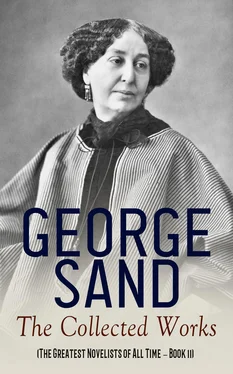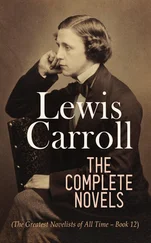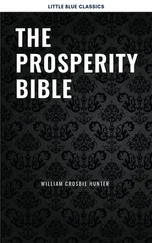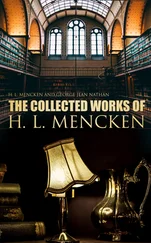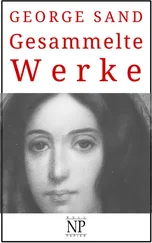George Sand
George Sand: The Collected Works (The Greatest Novelists of All Time – Book 11)
The Devil's Pool, Indiana, Mauprat, The Countess of Rudolstadt, Valentine, Leone Leoni, Antonia…
Translator: George Burnham Ives, Stanley Young, Katharine Prescott Wormeley, Fayette Robinson, Ralph Keeler
e-artnow, 2022
Contact: info@e-artnow.org
EAN 4066338121721
The Devil's Pool The Devil's Pool Table of Contents Notice I. The Author to the Reader II. The Ploughing III. Père Maurice IV. Germain, the Cunning Ploughman V. La Guillette VI. Petit-Pierre VII. On the Moor VIII. Under the Great Oaks IX. The Evening Prayer X. Despite the Cold XI. In the Open Air XII. The Village Lioness XIII. The Master XIV. The Old Woman XV. The Return to the Farm XVI. Mère Maurice XVII. Little Marie Appendix I. The Country Wedding II. The Livrées III. The Wedding IV. The Cabbage Footnotes
Indiana
Mauprat
The Countess of Rudolstadt
Valentine
The Sin of Monsieur Antoine
Leone Leoni
The Marquis de Villemer
The Bagpipers
Antonia
Table of Contents
Notice
I. The Author to the Reader
II. The Ploughing
III. Père Maurice
IV. Germain, the Cunning Ploughman
V. La Guillette
VI. Petit-Pierre
VII. On the Moor
VIII. Under the Great Oaks
IX. The Evening Prayer
X. Despite the Cold
XI. In the Open Air
XII. The Village Lioness
XIII. The Master
XIV. The Old Woman
XV. The Return to the Farm
XVI. Mère Maurice
XVII. Little Marie
Appendix
I. The Country Wedding
II. The Livrées
III. The Wedding
IV. The Cabbage
Footnotes
Table of Contents
When I began, with The Devil's Pool , a series of rustic pictures which I proposed to collect under the title of The Hemp-Beater's Tales , I had no theory, no purpose to effect a revolution in literature. No one can bring about a revolution by himself alone, and there are revolutions, especially in matters of art, which mankind accomplishes without any very clear idea how it is done, because everybody takes a hand in them. But this is not applicable to the romance of rustic manners: it has existed in all ages and under all forms, sometimes pompous, sometimes affected, sometimes artless. I have said, and I say again here: the dream of a country-life has always been the ideal of cities, aye, and of courts. I have done nothing new in following the incline that leads civilized man back to the charms of primitive life. I have not intended to invent a new language or to create a new style. I have been assured of the contrary in a large number of feuilletons , but I know better than any one what to think about my own plans, and I am always astonished that the critics dig so deep for them, when the simplest ideas, the most commonplace incidents, are the only inspirations to which the products of art owe their being. As for The Devil's Pool in particular, the incident that I have related in the preface, an engraving of Holbein's that had made an impression upon me, and a scene from real life that came under my eyes at the same moment, in sowing time,—those were what impelled me to write this modest tale, the scene of which is laid amid humble localities that I used to visit every day. If any one asks me my purpose in writing it, I shall reply that I desired to do a very simple and very touching thing, and that I have not succeeded as I hoped. I have seen, I have felt the beautiful in the simple, but to see and to depict are two different things! The most that the artist can hope to do is to induce those who have eyes to look with him. Therefore, my friends, look at simple things, look at the sky and the fields and the trees and the peasants, especially at what is good and true in them: you will see them to a slight extent in my book, you will see them much better in nature.
GEORGE SAND.
NOHANT, April 12, 1851 .
I. The Author to the Reader
Table of Contents
A la sueur de ton visaige
Tu gagnerois ta pauvre vie,
Après long travail et usaige,
Voicy la mort qui te convie. 1
The quatrain in old French written below one of Holbein's pictures is profoundly sad in its simplicity. The engraving represents a ploughman driving his plough through a field. A vast expanse of country stretches away in the distance, with some poor cabins here and there; the sun is setting behind the hill. It is the close of a hard day's work. The peasant is a short, thick-set man, old, and clothed in rags. The four horses that he urges forward are thin and gaunt; the ploughshare is buried in rough, unyielding soil. A single figure is joyous and alert in that scene of sweat and toil . It is a fantastic personage, a skeleton armed with a whip, who runs in the furrow beside the terrified horses and belabors them, thus serving the old husbandman as ploughboy. This spectre, which Holbein has introduced allegorically in the succession of philosophical and religious subjects, at once lugubrious and burlesque, entitled the Dance of Death , is Death itself.
In that collection, or rather in that great book, in which Death, playing his part on every page, is the connecting link and the dominant thought, Holbein has marshalled sovereigns, pontiffs, lovers, gamblers, drunkards, nuns, courtesans, brigands, paupers, soldiers, monks, Jews, travellers, the whole world of his day and of ours; and everywhere the spectre of Death mocks and threatens and triumphs. From a single picture only, is it absent. It is that one in which Lazarus, the poor man, lying on a dunghill at the rich man's door, declares that he does not fear Death, doubtless because he has nothing to lose and his life is premature death.
Is that stoicist idea of the half-pagan Christianity of the Renaissance very comforting, and do devout souls find consolation therein? The ambitious man, the rascal, the tyrant, the rake, all those haughty sinners who abuse life, and whom Death holds by the hair, are destined to be punished, without doubt; but are the blind man, the beggar, the madman, the poor peasant, recompensed for their long life of misery by the single reflection that death is not an evil for them? No! An implacable melancholy, a ghastly fatality, overshadows the artist's work. It resembles a bitter imprecation upon the fate of mankind.
There truly do we find the grievous satire, the truthful picture of the society Holbein had under his eyes. Crime and misfortune, those are what impressed him; but what shall we depict, we artists of another age? Shall we seek in the thought of death the reward of mankind in the present day? Shall we invoke it as the punishment of injustice and the guerdon of suffering?
No, we have no longer to deal with Death, but with Life. We no longer believe either in the nothingness of the tomb or in salvation purchased by obligatory renunciation; we want life to be good because we want it to be fruitful. Lazarus must leave his dunghill, so that the poor may no longer rejoice at the death of the rich. All must be happy, so that the happiness of some may not be a crime and accursed of God. The husbandman as he sows his grain must know that he is working at the work of life, and not rejoice because Death is walking beside him. In a word, death must no longer be the punishment of prosperity or the consolation of adversity. God did not destine death as a punishment or a compensation for life; for he blessed life, and the grave should not be a refuge to which it is permitted to send those who cannot be made happy.
Читать дальше
